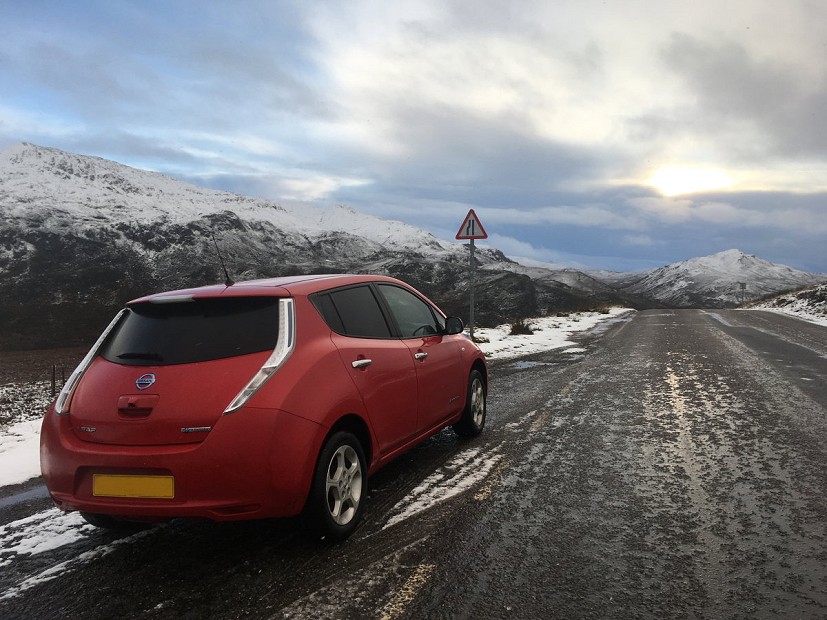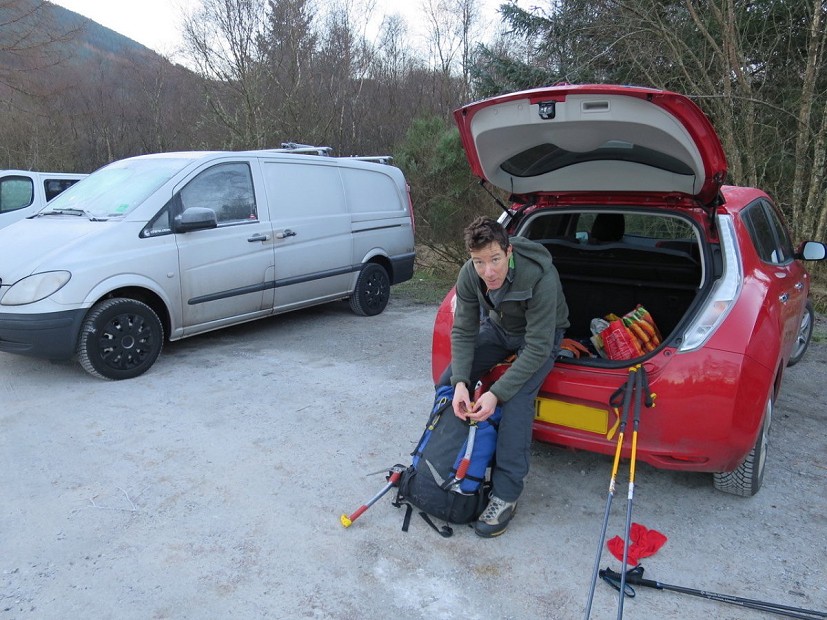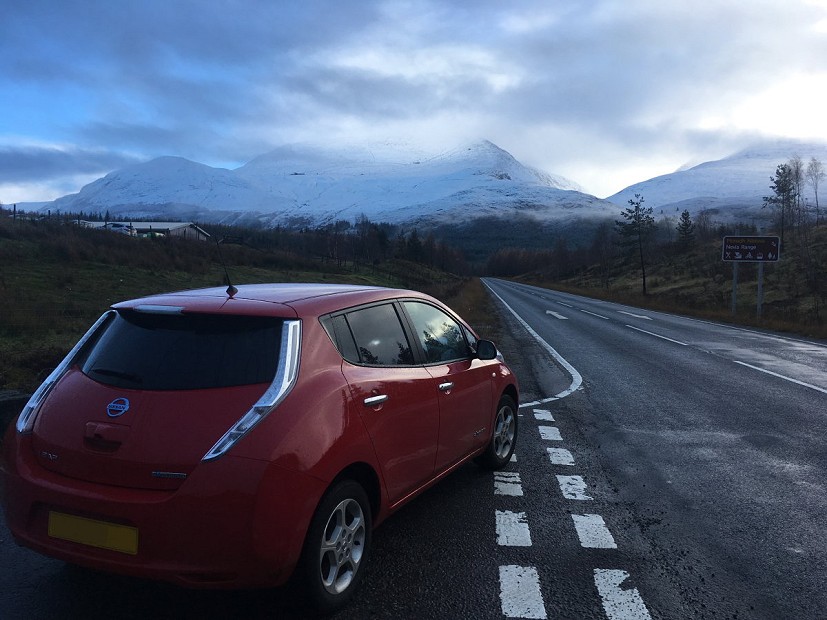
With access to hills and crags uppermost in mind, Es Tresidder examines the pros and cons of electric vehicles. Will he persuade us to ditch the diesel, and invest in battery powered travel?
In summer 2016 we made a big move from Brussels to near Fort William on the west coast of Scotland. Moving away from the good transport links of a big city had us looking to buy our first family car to make the most of life in the Highlands. From the limited battery range to the costs involved, would we be able to get by with an electric car for all our family and climbing needs? Has it proven a practical option for accessing crags and hills? Short answer, yes.
"Contrary to what I expected, the electric car actually works really well in a rural location. The performance in hills is not a worry at all. Because driving speeds are generally much lower in the mountains, the typical range I get is actually better than I’d get elsewhere in the country"
Electrifying transport is a big part of every strategy I’ve seen to move to a sustainable and zero CO2 economy, so I was keen to avoid an internal combustion engine (ICE) car if I could. Initially I thought an electric car in such a remote place would be a non-starter. Surely the range would be inadequate? What about the hills? But the more I looked into it the more I thought it could work. I checked maps of charging points and realised that in every possible direction from our new house there was a rapid charger (charge to 80% in 30 minutes) at least every 60 miles, which was comfortably within the range of the cars in our budget. But even experienced owners of electric cars were dubious of the idea; the message seemed to be that these cars were great for urban commuting or as a second car, but as your only car in the wilds of Scotland? Forget it.
What about for climbing/running/hillwalking/biking? After all we were moving to be close to adventure; would an electric car be restrictive for that? Would I be able to fit all my kit in? Would I get back to the car exhausted from a long day on the hill to find the battery had gone flat while I was away and was even more exhausted than me?
After much deliberation we finally decided to take the plunge and see what happened. A specialist dealer proved a font of information and found us a pre-registered 30kWh Nissan LEAF Acenta with a dozen miles on the clock for £16k, around £10k less than the list price! It was even red, our son’s favourite colour.
"We were getting typically between 120-130 miles of range per charge for Highland travel. Driving at 70mph on the motorway seems to drop the range to about 90 miles on a full charge"
The car’s stated range is 155 miles under the European testing method and considerably less under the US testing method (107 miles). Of course the range you actually get will depend very heavily on weather conditions, terrain and how you drive it, especially how fast you go (just as it does in an ICE car).
During last summer we were getting typically between 120-130 miles of range per charge for Highland driving. The faster you drive the more energy it takes (exponentially so, the relationship between speed and energy is a cube rule) and driving at 70 mph on the motorway seems to drop the range to about 90 miles on a full charge.
Contrary to what I expected, the electric car actually works really well in a rural location. The performance in hills is not a worry at all. I’m sure there is a difference in efficiency, but it’s small enough that I don’t notice it compared to flat driving. Of course it uses considerably more energy going uphill than on the flat, but much of that is won back by the regenerative braking recharging the batteries on the way back down. Crucially, because driving speeds are generally much lower in the mountains, the typical range is actually better than I’d get elsewhere in the country.
A typical scenario using it for accessing the mountains sees me arriving back at the car soaked, exhausted and near-hypothermic, hands not working well enough to find the key. Thankfully I don’t have to, the car knows I have the key in my pack and lets me in with a simple push on a button on the car door. Then I’m in, out of the weather, and warming up much more quickly than in an ICE car (since I don’t have to wait for the engine to warm up). Other than that, the experience is pretty similar to what you’ll be used to. I’ve left the car for days without charging it and the % charge has remained the same, so I wouldn’t be worried about leaving it for longer trips.
The batteries are all under the cabin, so don’t take away from boot space and luggage capacity is about what I’d expect for a car of this size. In fact, because electric motors take up less room than their fossil fuelled counterparts, if the designers are clever about battery siting you can end up with more storage than an ICE car; the Tesla Model S has a front ‘boot’ in addition to a sizeable rear one!
In terms of driving around the Highlands it has not so far felt at all restrictive, and I don’t anticipate it doing so. As a climber and mountaineer I have a wealth of superb venues within a range that requires no top-up charge and a lifetime’s worth of adventures elsewhere in the Highlands, all of which are accessible with a half-hour stop or two to fast-charge. I suspect an electric car with a range similar to mine (and they are improving all the time) can work really well for anyone who lives within a 100-mile radius of the crags or hills they mostly want to drive to, or as a second car. An electric car is nicer to drive than an ICE car for most journeys (see text box), and stopping once or twice for half an hour doesn’t feel an imposition to me at all, plus it’s nice to never have to go to a petrol station.
"Of course it uses considerably more energy going uphill, but much of that is won back by the regenerative braking recharging the batteries on the way back down. Crucially, because driving speeds are generally much lower in the mountains, the typical range is actually better than I’d get elsewhere in the country"
For those that live a long way from where they want to be climbing, things get a little more complicated. Let’s look at a hypothetical situation of someone in central London wanting to climb in north Wales. If they are wealthy enough to afford a Tesla model S (with a range of 300 miles) then no problem, hardly any change needed from driving an ICE car, just fill up with electrons instead of hydrocarbons. More realistically how would it work driving a 30 kWh Nissan LEAF (the car I have, the highest range non-Tesla electric car available at the time I bought it)? Assuming they start with a full charge and then re-charge to 80% at each stop, something like the following list of charge points ought to work.
- Cherwell services: 65 miles
- Norton Cannes services: 71 miles
- Chester services: 75 miles
- Llanberis: 72 miles
For each of those legs, there are intermediate stops you could do in between if weather conditions meant you weren’t able to get your desired range. Assuming you can charge wherever you are staying in Llanberis (there is a fast charger where you turn off the A55 if you cannot), that’s an additional three half-hour stops compared to driving in an ICE car with no stops at all. Use one of those stops for a meal and that sort of journey feels completely reasonable.
"For those that live a long way from where they want to be climbing, things get a little more complicated..."
For the truly adventurous much longer journeys are possible. Sheffield to Torridon, for example, would require eight stops to charge, or four hours of charging, plus a bit of time for the fact that you’re more likely to stick to the speed limit in an electric car (since you’re more conscious of driving efficiently). Compared to tag-teaming the drive north, only stopping once to refuel, this sort of journey requires a large change in mindset or the occasional hiring of an ICE car[1].
The experience of owning an electric car has on the whole been very good, but we have had two minor epics:
The first in the very early days, leaving the house for a trip to the beach at Arisaig with only 65% charge (before we had the home charger installed) thinking it would probably be OK and if it wasn’t I could nip to Mallaig where there is a fast charger. It wasn’t enough and when we got to Mallaig the charger wasn’t working. This is the only time I’ve had a charger not work, in general they seem to be very reliable. I found a friendly man at the harbour who let me plug into his wall socket for two hours before I drove very slowly home. Now we’ve got a home charger and never leave for a long journey without a fully charged battery.
The second was driving to Derbyshire (400 miles from here) to see family in stormy weather with gale-force southerly winds. The range was massively reduced and we had to stop seven or eight times to charge. On the way back the weather was calmer and the whole journey was really nice, we stopped five times, the last one just a 10-minute top up. I think in future if the weather forecast was as bad I would either change my plans or split such a long journey halfway.
I thought having an electric car would be one of those things, like rarely flying and heating my house at 19 degrees, that I do because I’m concerned about climate change, but would be easier not to do. On the contrary I’d say for our lifestyle it’s a nicer, more convenient car to have. The experience so far has been really positive and it gives me hope that electric cars can very rapidly take over from ICE cars in the years to come as people come to realise they are just better cars. This process will be helped along by several cars due in the next two or three years with double the range of ours, and retailing for a similar price.
Why electric?
Nicer to drive
Electric cars have several characteristics that make them nicer to drive than an ICE car. They are extremely quiet which makes driving feel a bit less stressful and listening to music or having conversations with other passengers much more pleasant.
They accelerate very quickly and smoothly since an electric motor can deliver full torque at any speed and because there are no gears to shift through as the car gains speed. They corner well because the weight of the batteries keeps the centre of gravity low.
They’re much easier to drive in traffic at very low speeds – no stalling or constantly changing in and out of gear, just lightly weight or unweight the accelerator.
Now I’m used to driving one I find I rarely use the brake pedal (only for coming to a complete stop or if I have misjudged how quickly I need to slow down). Simply taking my foot off the accelerator engages the regenerative braking and I gradually slow down.
It warms up really quickly because you don’t have to wait for the engine to warm up before heating the cabin. You can even pre-heat it before you get in using a smartphone!
Environmental impact
Petrol and diesel engines are typically about 20% efficient. Electric motors are much more efficient (about 90% efficient). This means that although UK grid electricity has higher CO2 emissions than petrol/diesel per unit of energy, the CO2 emissions per mile of an electric car are considerably lower than even the most efficient ICE cars. Furthermore, since grid electricity can be decarbonised, a future of zero CO2 emission electric cars is possible. Not so with ICE cars.
As well as being better for the global environment, electric cars produce no emissions while driven, so contribute much less to local air pollution. Poor air quality is thought to shorten many thousands of lives per year in the UK as well as contributing to various health problems. Because they are much quieter electric cars also reduce noise pollution.
Costs
Although electric cars are typically more expensive to buy than their fossil-fuelled counterparts, their fuel costs are much lower. Typical electricity costs for me are about 2.2p/mile if charging at home (on a night tariff) and currently free for most fast charging on longer journeys. Even at the rate charged by Ecotricity for their motorway chargers (£6 per half-hour charge[2]) electricity costs are about 6.25p/mile, considerably cheaper than fuelling an ICE car.
Maintenance costs should also be lower on electric cars, since their motors are much simpler and the brakes used much less (due to the regenerative braking).
Reduced fuel and maintenance costs can mean that the lifetime cost of owning an electric car is lower than an equivalent ICE car[3].
What about the cold?
Winter climbers and walkers need a car that can drive in the cold. Cold affects the efficiency of all cars, but it’s more of a worry in a car where the range may be tight already. The cold affects the range of electric cars in two ways:
First of all there is an additional energy requirement to heat the cabin. For short journeys this can make a big difference to the energy used per mile driven (since warming the car up from cold takes a lot of energy). On longer journeys this impact will be smaller. Pre-heating while still plugged in to mains electricity is a good idea so you can start a long journey with a warm car and 100% charge. You can minimise the energy used for heating by wrapping up warm and turning the heating down or off.
The second effect is that in cold weather the electrons in a battery are less active, so you can’t draw as much energy. I have certainly noticed this on short journeys during a recent cold snap. I suspect that for long journeys, where the range really matters, it will be less of a problem since the battery warms up when driven and when fast-charged.
Most of the time I’ve owned the car it’s been summer (I bought it in July and am writing this in winter). We’ve had some cold weather and I’ve watched the range and efficiency with interest but I’m yet to do a long journey in sub zero temperatures. However, I’m reassured by the fact that the country where electric cars are most popular is Norway, a country not known for its mild winters!
One way street
What if you are driving to a remote roadhead somewhere, then leaving the car, perhaps for a few days, before returning? How much charge would be a comfortable margin? In my experience the battery doesn’t lose significant charge when not driven, so assuming you charged to 100% and the roadhead is at the same altitude as where you charged, leaving it with a little bit more than 50% should be fine. Having a safety margin of 10 or 15% in there (so leaving it with 60 or 65% charge), to allow for adverse weather on the return leg, might be wise, as would allowing some extra if the roadhead is significantly lower than the charging point.
Battery life
Batteries deteriorate with use, and the amount of energy they can store decreases. The batteries on my car are guaranteed to lose no more than 3 of the 12 bars (this equates to guaranteeing they will retain at least 67% of their capacity) within eight years or 100,000 miles (whichever is soonest). With this much capacity loss the car will still be fine for most people on day to day journeys[4] but much less so for long journeys. In general battery life in the UK seems to be quite good due to the temperate climate (batteries deteriorate especially fast in very hot weather), but if the batteries do deteriorate to the point of range becoming a problem I would consider selling and upgrading to another electric car with a bigger range. By the time battery capacity is significantly reduced I expect there to be a much better choice of long-range EVs, and for purchase prices to be more competitive with ICE cars.
Day-to-day charging
If you have access to a dedicated charger, either by installing one at home or using one at work, running an electric car can feel more convenient than an ICE car for all but really long journeys. Just plug it in when you get home/to work and unplug it when you want to drive. If you’re on a cheap night-time tariff or have solar panels, you can set a timer in order to make sure the charging takes place at the right time.
What happens if you run out of juice?
In the event that you do run out of juice (you’ll have lots of warning, a display tells you what % you have remaining) you have two options – call a rescue or find someone who will let you charge from a normal 3-pin socket till you have enough to get to a faster charger. Charging on a normal socket is much slower (since they supply at a power of ~3 kW compared to 50 kW on a fast charger). You’ll get around 12 miles of range per hour of charging, but in a remote location that might be much quicker than waiting for a rescue. Charging from a standard socket is also a good option for overnight charging if where you are staying does not have a dedicated EV charger.
Why bother?
Until recently I thought the reason for me to minimise my CO2 emissions was to align what I advocate with how I act. I spend all of my professional and much of my personal life engaged with the climate change challenge and solutions to it, and to not ‘walk the walk’ while talking the talk leaves me feeling distinctly fake and uneasy. I reasoned that personal changes are piffling on a global level but were a salve for my conscience and gave credibility to the wider action I believed in. However, a recent report from Oxfam[5] changed my view on this. The highest emitting 10% of individuals globally are responsible for 50% of greenhouse gas emissions. I suspect most of the climbers I know, with a culture of lots of driving and flying to access adventure, are in this group. The evidence is clear that, in order to avoid dangerous levels of climate change, the faster and deeper we can decarbonise the better. Reducing the emissions of the top 10% of emitters to the level of the average EU citizen would slash global greenhouse gas emissions by 30%[6]. That’s not a massive sacrifice in terms of lifestyle, for a large and potentially rapid cut in emissions. In light of this, making these changes on a personal level, and influencing others to do the same, is perhaps one of the most effective things I can do about climate change.
Useful links
https://evhighwaystatus.co.uk/?lat=56.92736&lng=-4.60764&z=8 and http://www.plugshare.com for route planning and charger locations.
http://carboncounter.com Interesting and powerful web tool from researchers at MIT looking at costs and greenhouse gas emissions from a range of different cars. Data is from the USA but still gives some great insights, most of which will be broadly applicable to the UK.
http://www.drive-electric.co.uk Electric car leasing.
http://eco-cars.net Second hand and pre-registered electric cars.
[1] Nissan actually offer 2 weeks of ICE car hire, and free European-wide rescue, as part of the deal when you buy a LEAF.
[2] Ecotricity electricity customers get 52 free charges per year on their motorway charge network.
[3] This was the conclusion of an MIT study of the US car market. See http://carboncounter.com
[4] http://www.sciencedirect.com/science/article/pii/S0378775315000841
[5] https://www.oxfam.org/en/research/extreme-carbon-inequality
[6] http://therealnews.com/t2/index.php?option=com_content&task=view&id=31&Itemid=74&jumival=17692
Abour Es Tresidder
Es is a climber and runner with many Scottish winter, mountain running and mountaineering accomplishments to his name. He works as a certified Passive House and low-energy retrofit designer. You can find out more about his work at www.leangreenconsulting.co.uk Es is sponsored by Mountain Equipment.
- Adidas Evil Eye Half Rim Pro Sunglasses 11 Oct, 2011
- Petzl Hirundos ? an alpine harness? 22 Mar, 2010
- Exped DownMat 7 Pump (with video) 3 Mar, 2010
- Adidas Terrex Pro Sunglasses 1 Feb, 2010
- REVIEW: Adidas Yodai Goggles 21 Dec, 2009
- Environmentalism and Climbing: An Uneasy Partnership 18 Aug, 2009
- Rockfax Winter Climbing + 25 Jun, 2009
- Meeting The Godfather 11 Mar, 2009
- British Tasermiut Fjord Expedition Report 25 Aug, 2008











Comments